Learn everything you need to install a basic drip system for watering raised garden beds. If you dream of having a thriving vegetable garden, this article will have your garden blooming in no time! Follow along and learn how to install simple drip irrigation for multiple raised garden beds. If you’re starting from zero, read my post with all the instructions for building a raised garden bed.
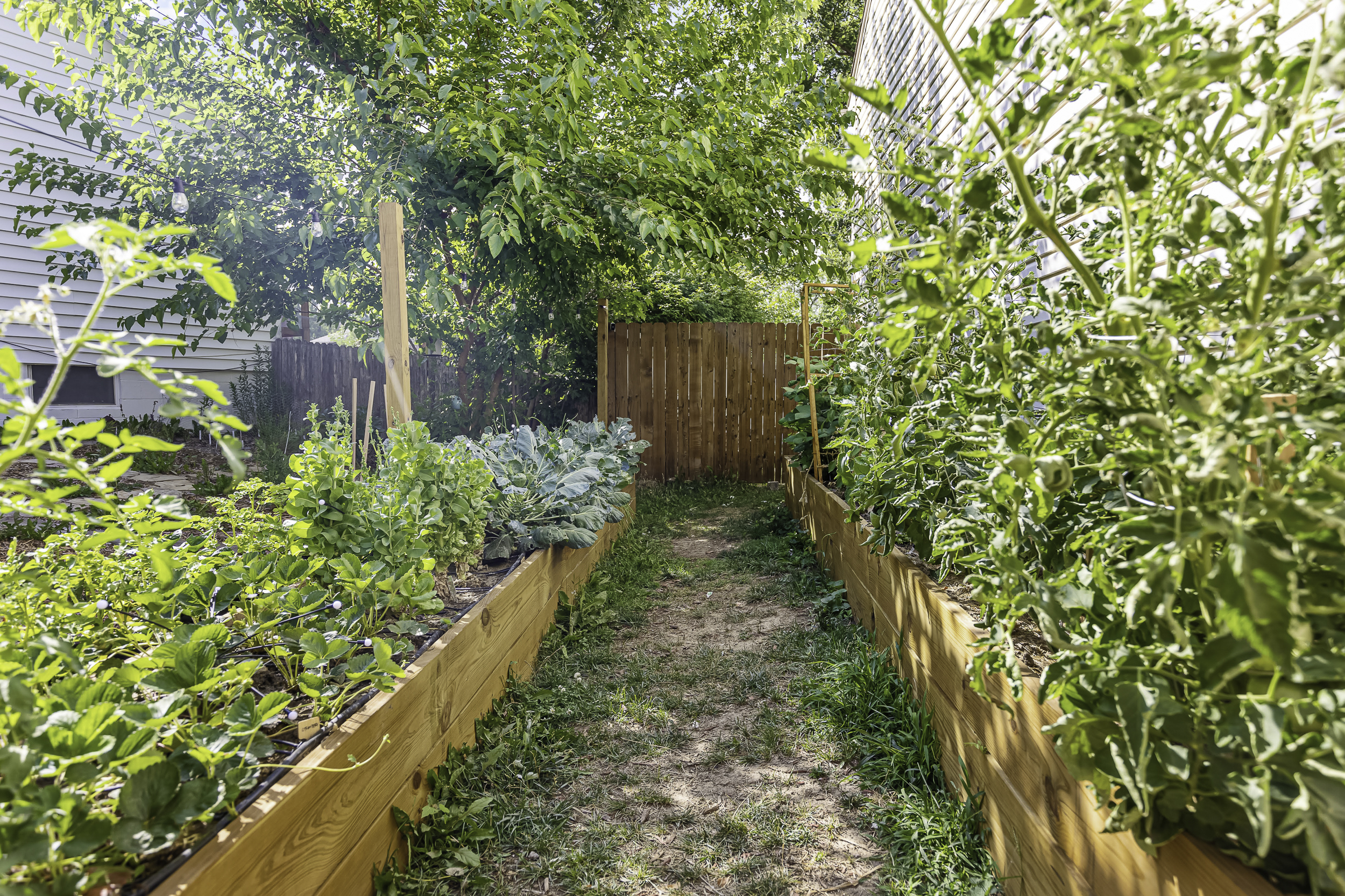
When it comes to gardening, I’m a total novice. I grew up in the desert, and things don’t like to grow in the desert. Even with a watering system installed, there are lots of other challenges with trying to grow a garden in such a climate, so I never did. But now that we are in Omaha, where plants grow without even being asked to, I decided that now is the time to fulfill my lifelong dream of having a green thumb. Setting up a drip line system is actually very simple… it’s kind of like doing plumbing in a house, only way easier because there are no walls to have to work around.
Why Should You Install a Drip System for Watering Raised Garden Beds?
Five reasons you should install a drip system for watering raised garden beds:
#1 – You want to avoid setting alarms on your phone to remind you to stand outside in the hot sun holding a hose – maybe you envisioned being outside at sunrise, walking plant to plant with a watering can, listening to the birds sing. It’s a nice image, but it’ll get old very quickly.
#2 – You want things to grow – regular watering keeps your plants happy, and happy plants yield bountiful harvests.
#3 – You like maintaining good relationships with your neighbors – no matter what they say, they don’t want to come water your garden for you while you’re out of town.
#4 – You don’t like wasting water – a drip system saves 30-50% more water than hand watering.
#5—It’s easier than you think—installing a drip system took us less than half a day.
What You’ll Need to Install a Basic Drip System For Watering Raised Garden Beds
To install a basic drip system for watering raised garden beds, here’s what you’ll need –
- 1/2 Inch Main Irrigation Tubing – We used 1 roll
- Hose Bib Splitter
- 1/2-in Irrigation Collar – Female Adapter
- 1/2-in Irrigation Collar – Male Adapter
- 1/2-in Irrigation Collar End Cap
- Adjustable Clamp
- Landscape Stakes
- Goof Plugs
- 1/2-in Irrigation Elbow
- 1/4-in Drip Tubing
- Programmable Timer
- 3/4-in Hose Adapter Fitting
- Back Flow Preventer
- 1/2-in T-Connector
- Figure 8 Clamp
- Drip Line Hole Punch
- Sharp Garden Shears
- Pipe Straps
- 1/4-in Drip Coupling
- Drip Emitter
- Drip Line T-Connector
Step 1 – Sourcing Water for a Basic Drip System
The first step when installing a drip system for watering raised garden beds is to figure out the nearest water source to your garden. Our garden beds are on the side of our house, separated from our backyard by a fence. If your water source is far from your garden, like ours, it’s fine.
Step 2 – Hose Bib Setup for a Basic Drip System
Because we have only two hose bibs, we attached a hose splitter to the bib closest to our garden.
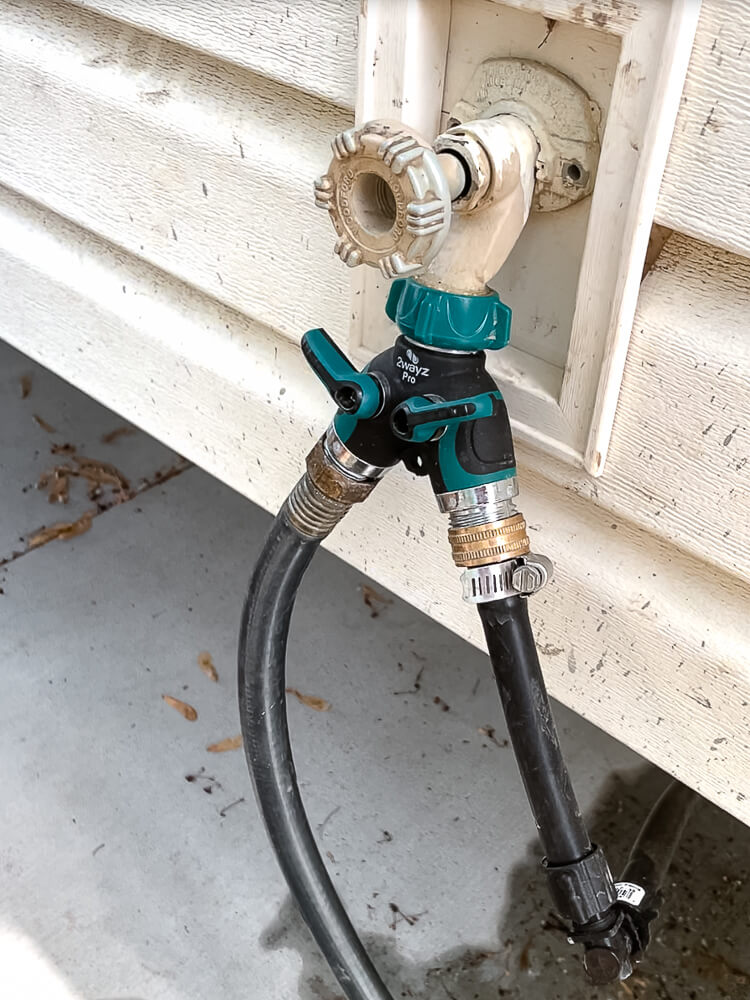
We “built” a hose using 1/2-inch poly tubing because both ends are plain. First, I slipped the adjustable clamp on one end and used a flame lighter to heat the tubing to make it more pliable so the hose adapter would fit tight inside.
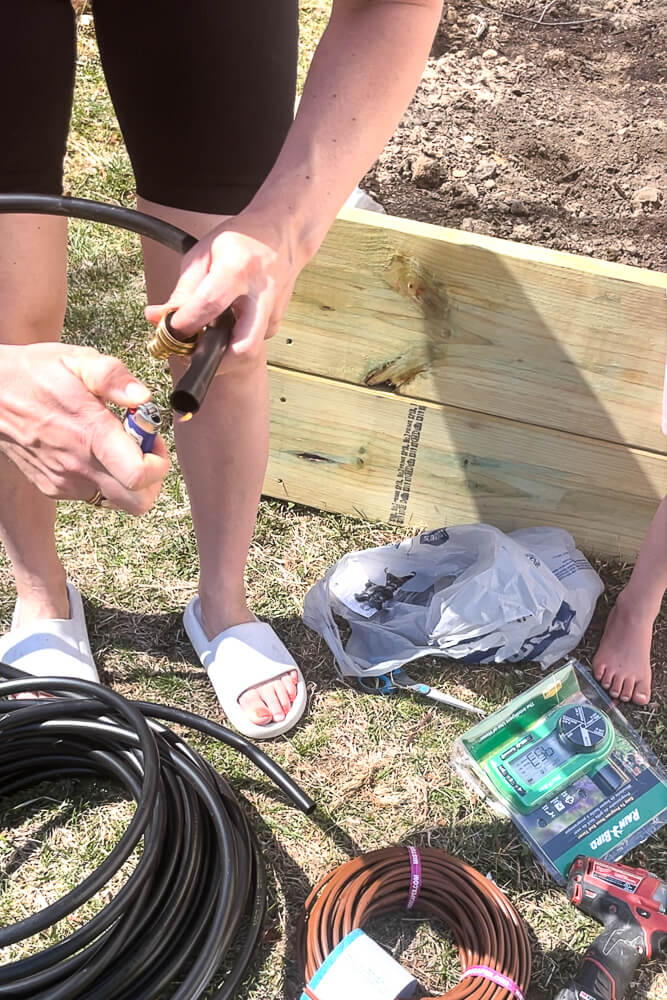
Then I used my drill to tighten up that clamp around the adapter. I now have a hose! That end was attached to the splitter and became our main line.
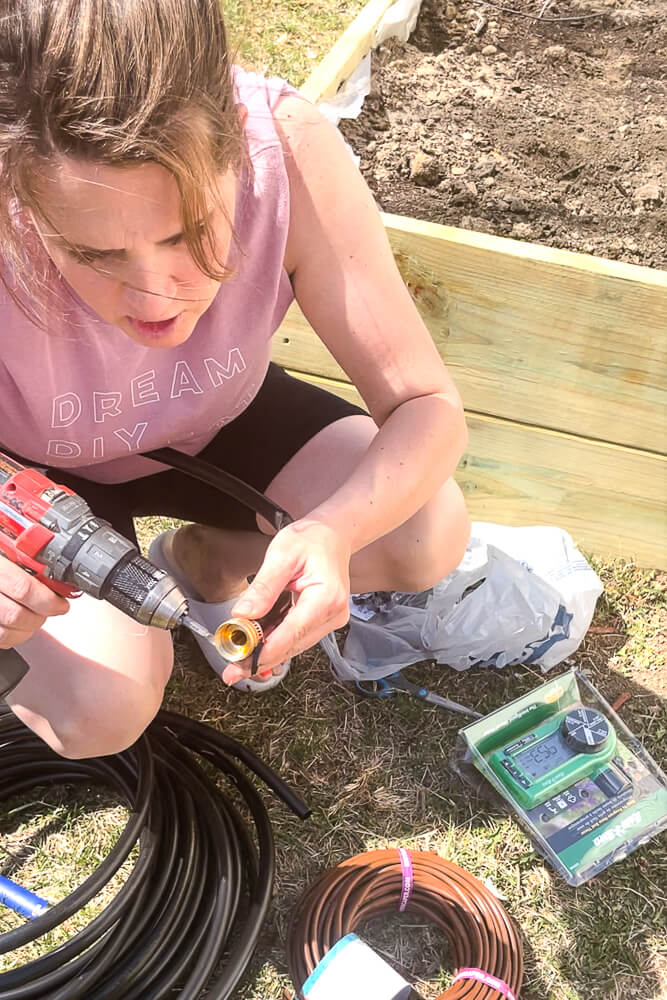
Step 3 – Adding Elbow Joints to the Drip Tubing
Adding elbows to the main line is easy. All you do is figure out where your drip tubing should turn a corner and cut it at that point using something super sharp like garden shears.
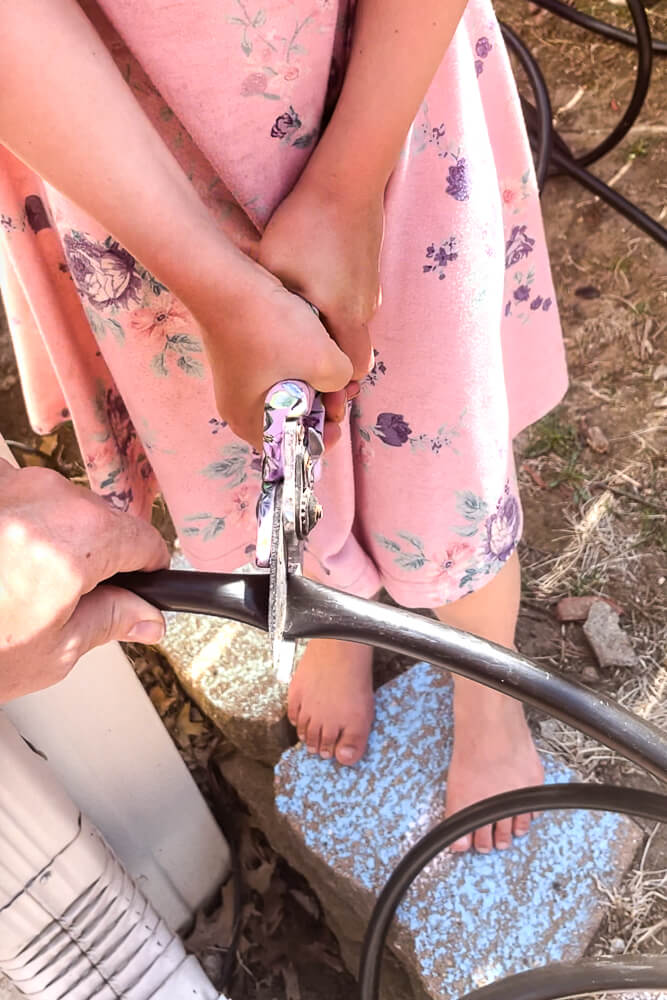
Then screw the elbow to the tubing. The threads in the elbow grip the tubing and make it watertight.

Our main line had to turn a few corners, so we used a lot of elbow joints. As we added elbows, we attached the poly tubing to our house using pipe straps.
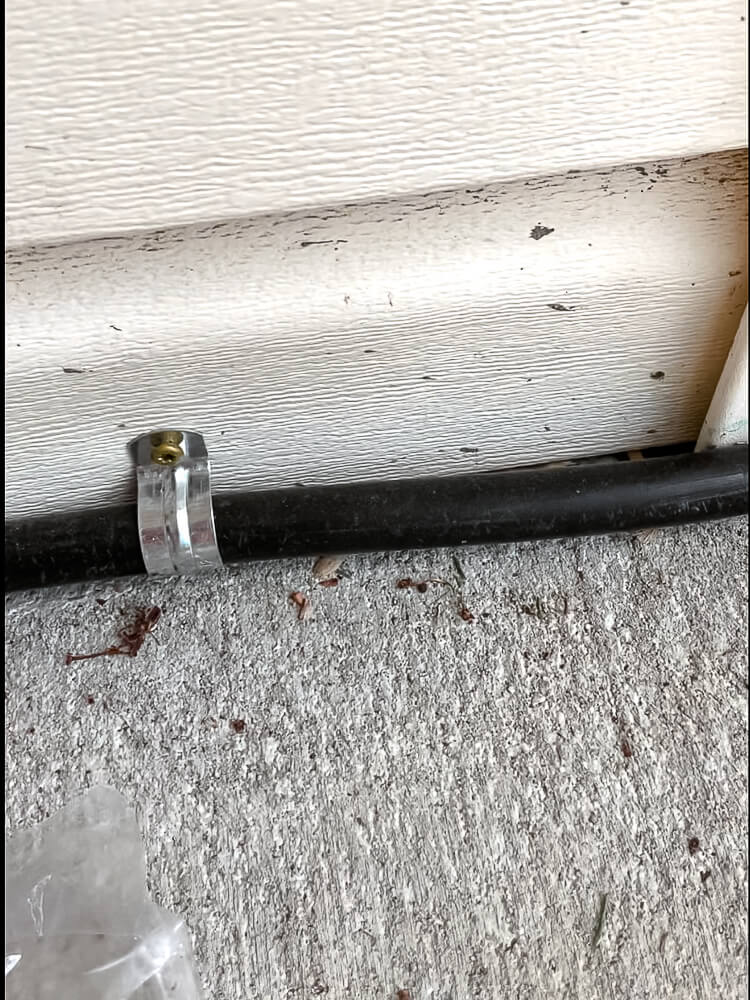
Step 4 – Installing an Irrigation Timer
We wanted the timer to hang on the side gate, so we fastened the poly tubing to the gate and cut it. Then we screwed a female irrigation adapter to the end of the tubing and attached the timer. We connected a backflow preventer, a male irrigation adapter, and more poly tubing to the timer.
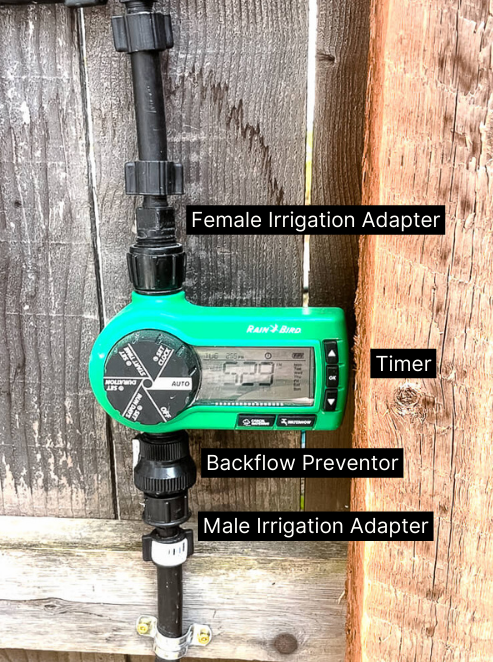
From there, we continued running the poly tubing until it finally reached the ground next to the planter boxes.
Step 5 – Splitting the Main Line Into Two Parts
We’ve got two garden beds to water, so the next step was to split the main line into two. First, we cut the main line close to the corner of the first bed and set it aside.
Next, we dug up some dirt to create a small hole underneath the corner of the bed. FYI, it’s easier to do this before installing a drip system for watering raised garden beds, so learn from our mistake.

Then we took a long stake and pushed it down through the top of the garden bed until it touched the ground. This was challenging and was another thing we should have considered during the garden bed installation.
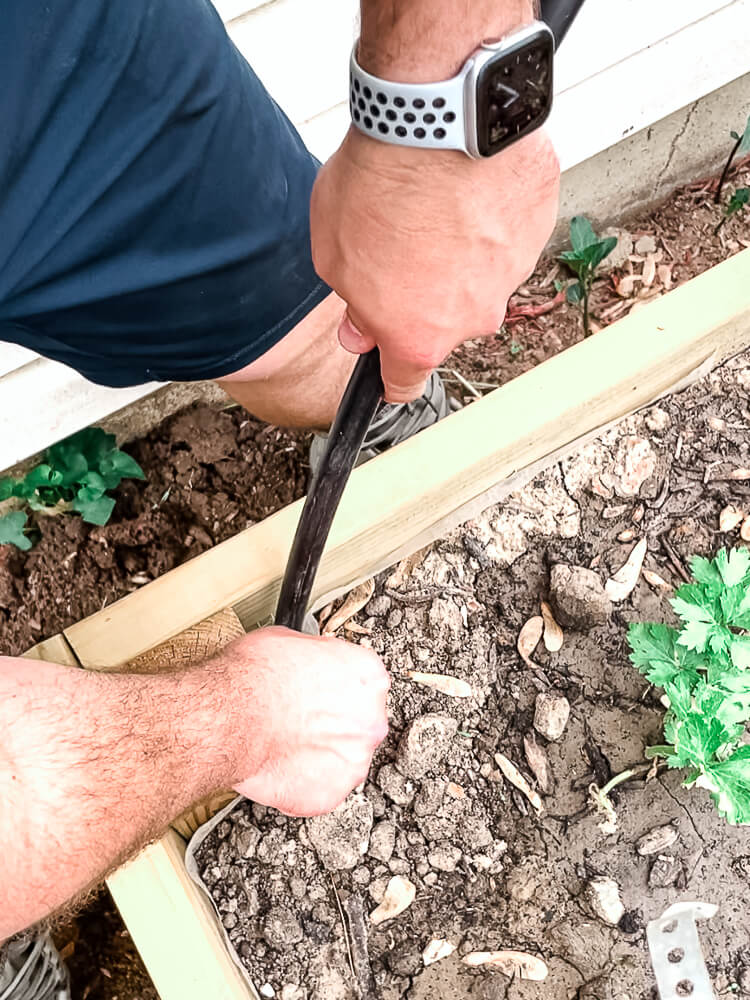
We snaked tubing down that hole and back up through the hole in the ground to meet the main line. Thinking about a kink in a drip line will keep a gardener up at night, so we attached an elbow to the end of that tubing so it could turn that corner more easily.
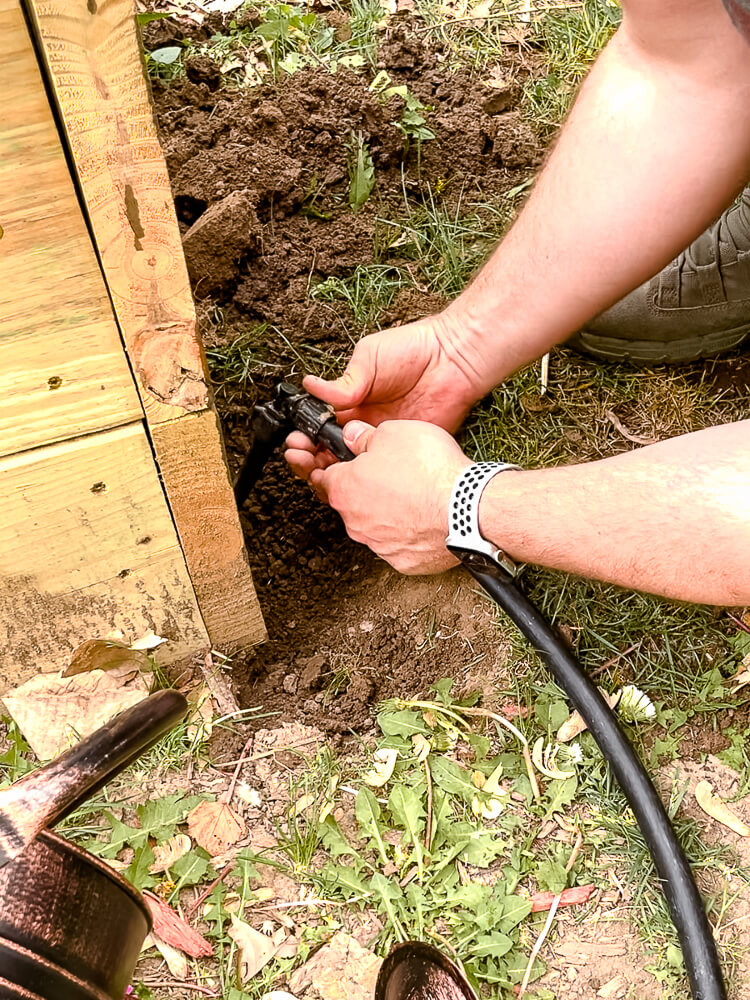
Step 6 – Adding a T-Connector
The next step is to use a T-connector to connect the main line to the tubing we shoved down the hole. It’s another simple setup, and the T-connector easily grips the tubing. Then we attached additional tubing to the T-connector that would run to the other garden bed.
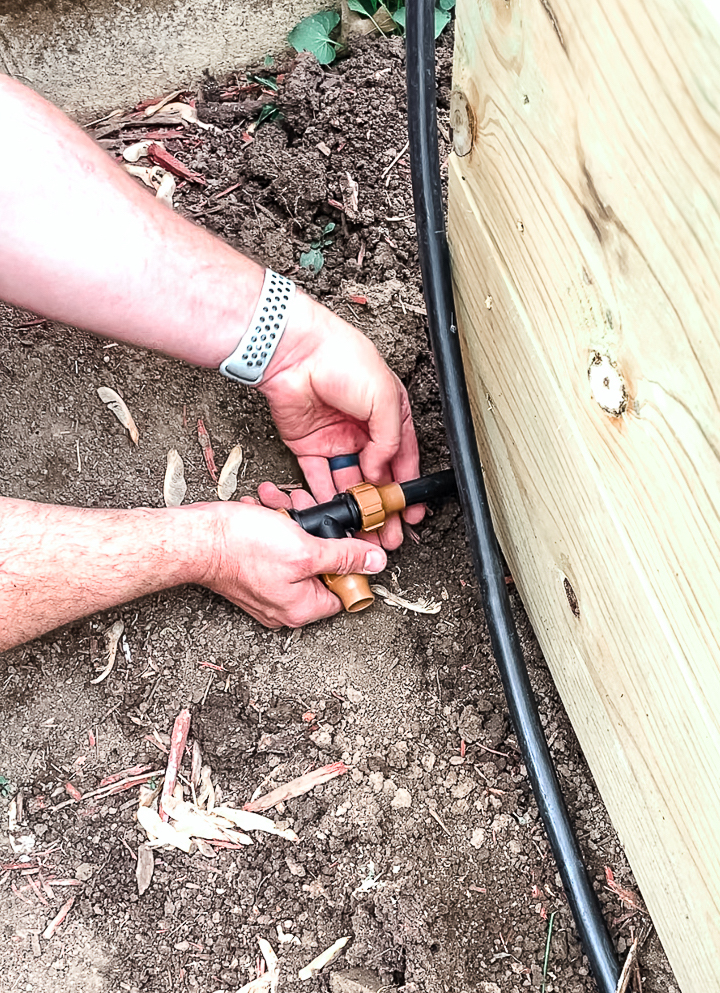
Step 7 – Getting Water to Both Garden Beds
The other garden bed got the same treatment: we dug a hole in the ground at the corner, shoved a stake down through the top of the garden bed, and then snaked some tubing down through the hole until it met up with the tubing we just connected to our T-connector.
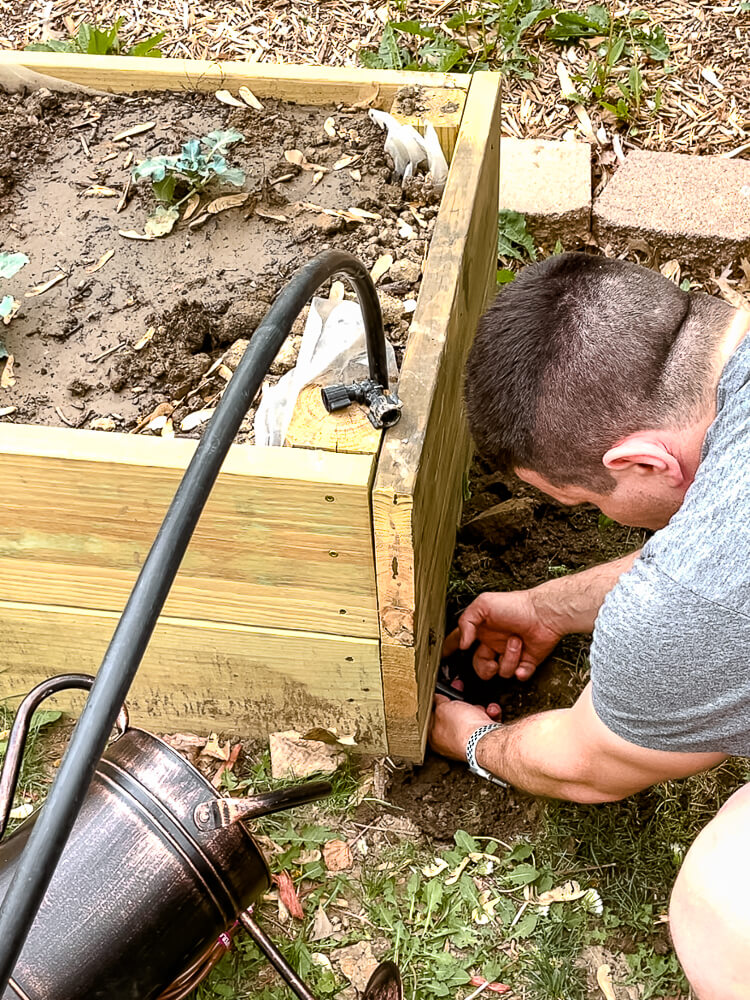
We used another elbow to connect the two pieces of irrigation tubing, and now the groundwork was mostly complete! When installing a drip system for watering raised garden beds, it is best to dig a trench about 6 inches deep to protect your poly tubing from the sun and tripping bodies.
Step 8 – Staking Down the Header Line
With the tubing sticking out the top of each bed, we added another elbow joint so it would lay flat against our topsoil and become our header line.

We ran the tubing down the length of the bed and used landscape stakes to secure it into place. Then we cut the tubing at the end of the garden and added an end cap clamp so water wouldn’t escape.
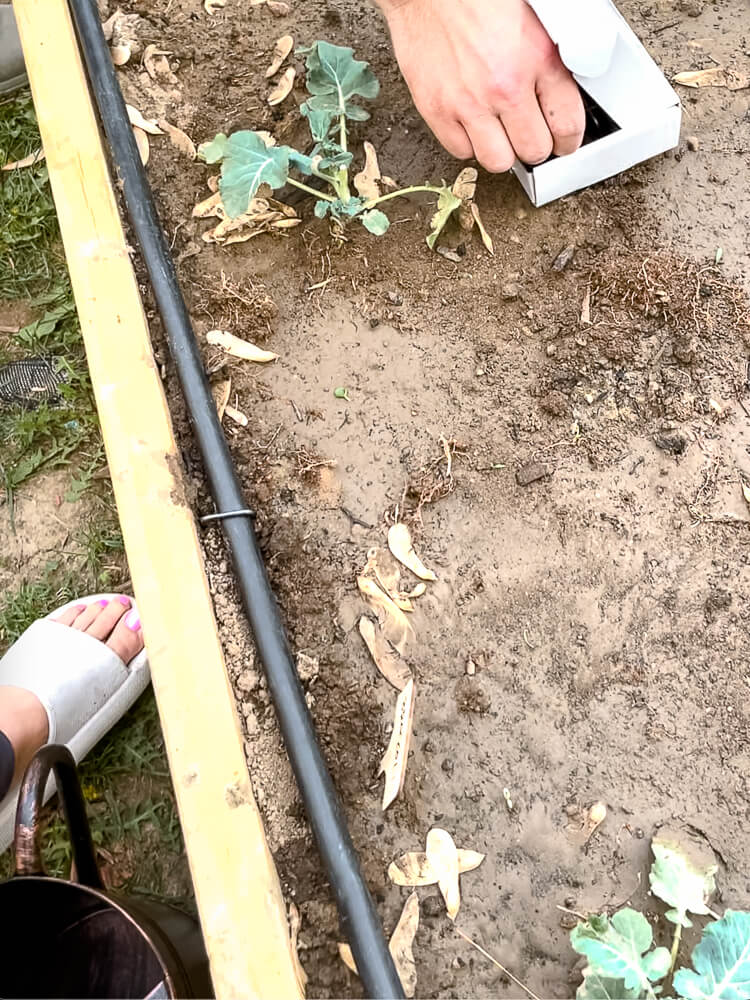
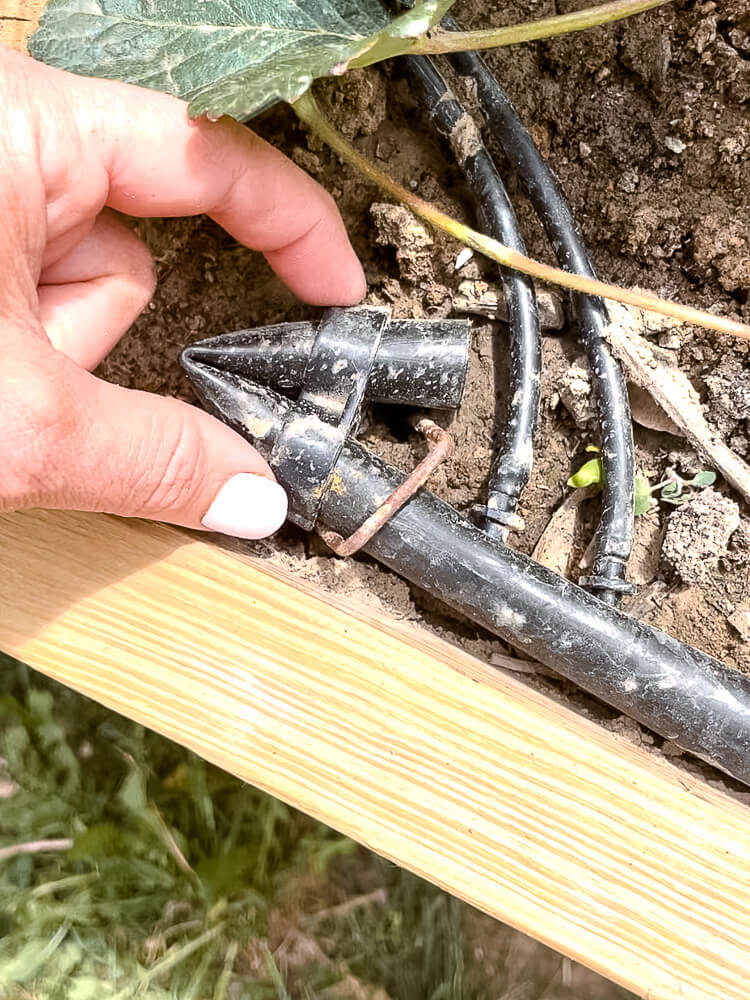
It was finally time to add our drip line! We’re almost done installing a drip system for watering raised garden beds!
Step 9 – Installing Drip Line To Irrigate Raised Beds
Adding a drip line to the header line is super easy.
First, we punched a hole into the header line.
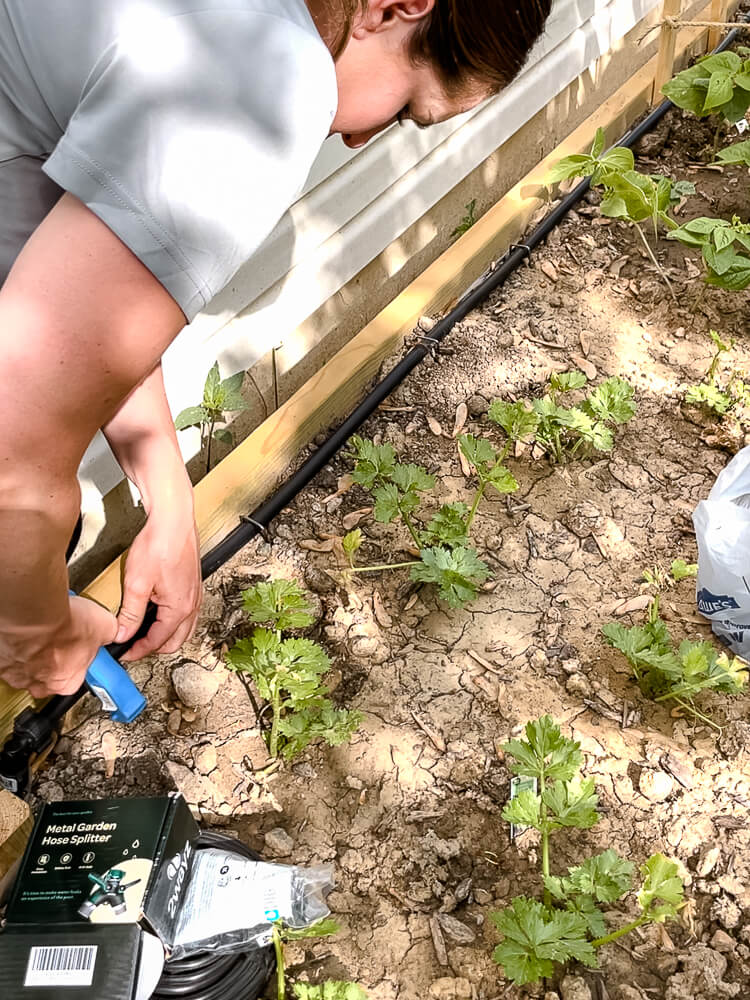
Then, we cut the 1/4-in drip tubing into lengths that reached our plants. Next, one end was slipped over a 1/4-in drip coupler and inserted into the punched hole. Last, the other end was slipped over an emitter. We used landscape stakes to keep the drip line in place.
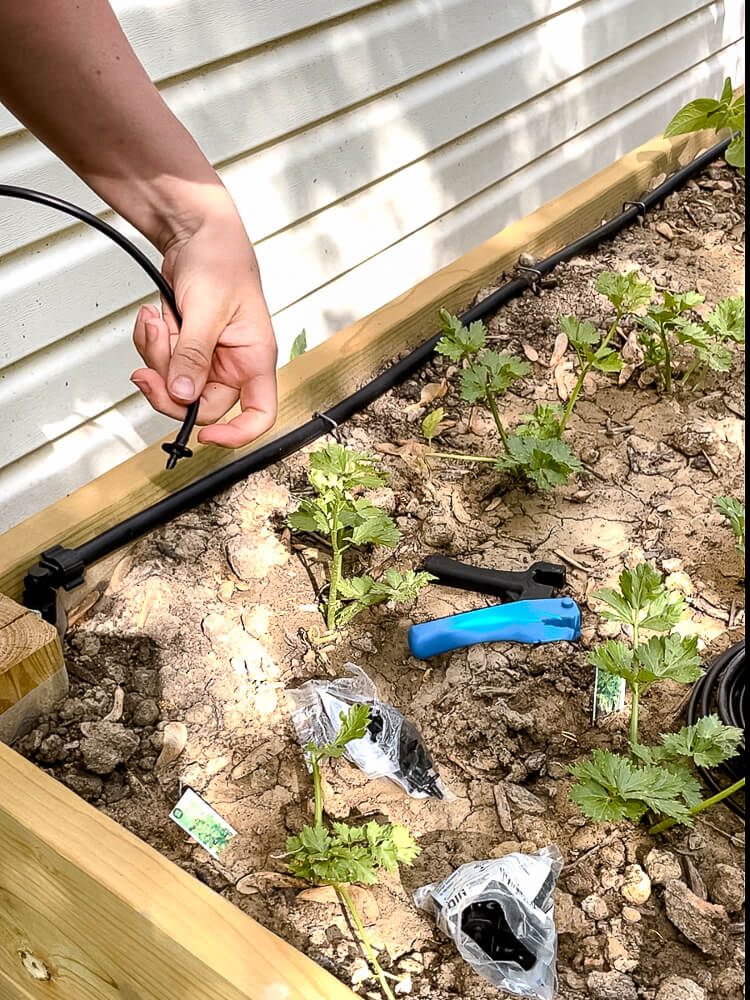

We used drip line T-connectors to add additional lines for the hard-to-reach plants. If you get overzealous with your hole punch, you can place goof plugs in the holes.
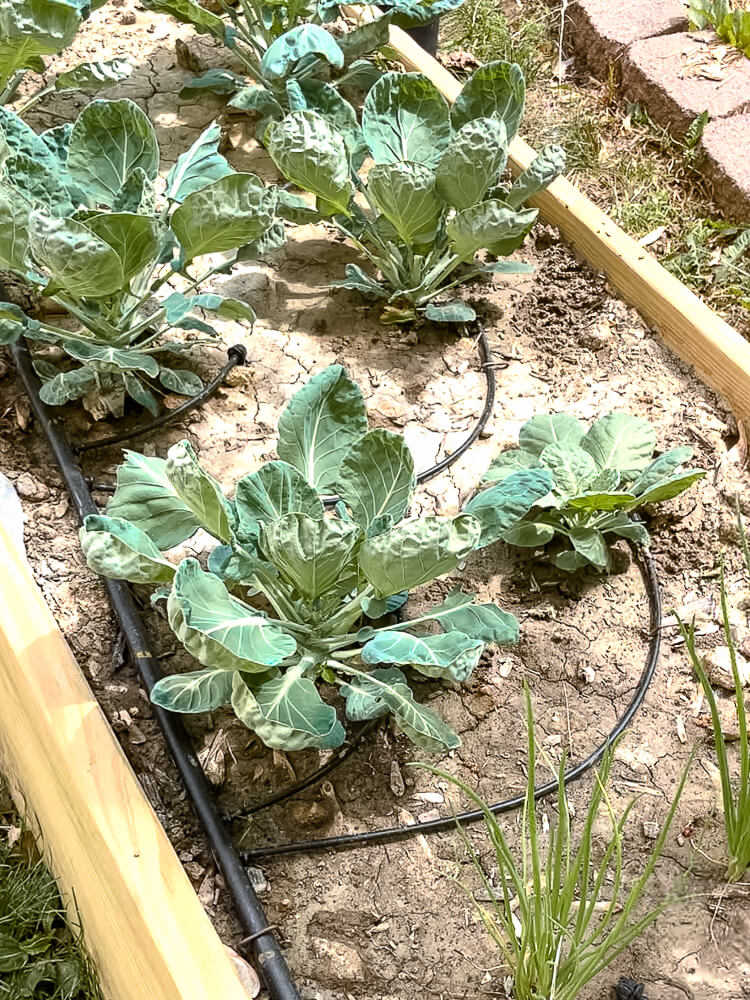
Watering Raised Garden Beds Tips
- Watering in the morning is best. The water evaporation rate is higher in the middle of the day, and the sun can turn water droplets on the leaves into tiny, scorching magnifying glasses.
- I set my timer to run for 15 mins in the mornings, but do your research. Watering amounts depend on your climate, season, rainfall amount, etc.
- Check your timer periodically to ensure the battery is still working. After installation, check your system for leaks, over-watering, under-watering, etc.
- Rainwater is the preferred water for plants. It contains minerals that treated tap water lacks.
- Rain gauges will let you know how much rain has fallen, and you can use that information to determine if you need more or less water that week. Some will automatically turn off your system if the rainfall has reached a specific limit.
Time To Install Your Basic Drip System
And that’s it, folks! This is everything you need to know (and more) about installing a drip system for watering raised garden beds. No one has ever regretted self-automating their watering, and you’ll be thankful you invested the time.
Feel free to comment or ask a question below, and if you found some value in this information, pin or share this post. I’d appreciate it, and I appreciate you! Happy harvesting!
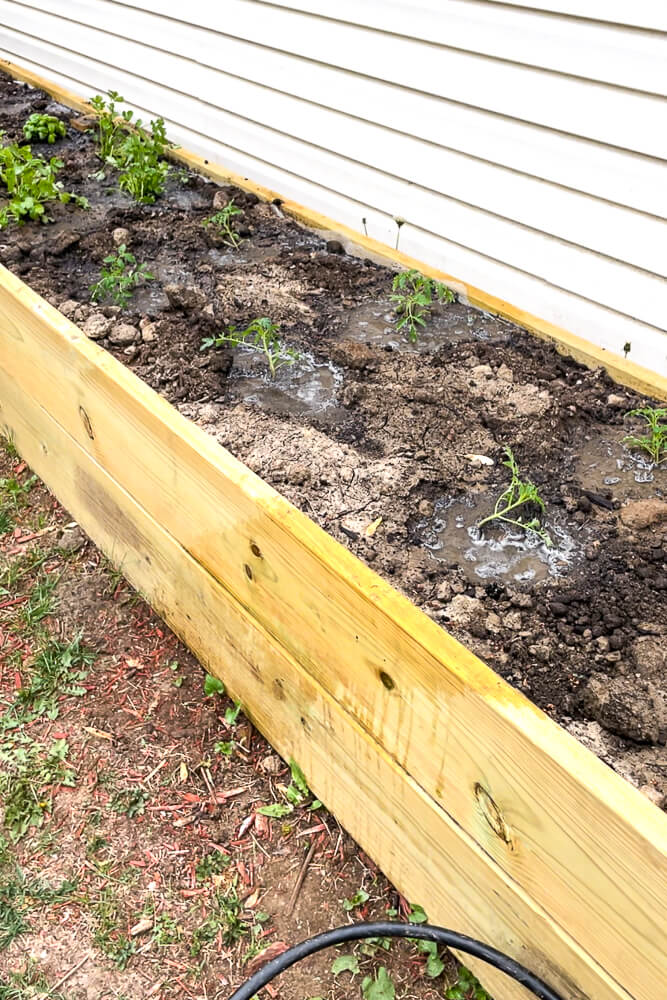
Related articles you may like:
DIY Tall Outdoor Planter Boxes for the Garden
XOXO,
Crystel
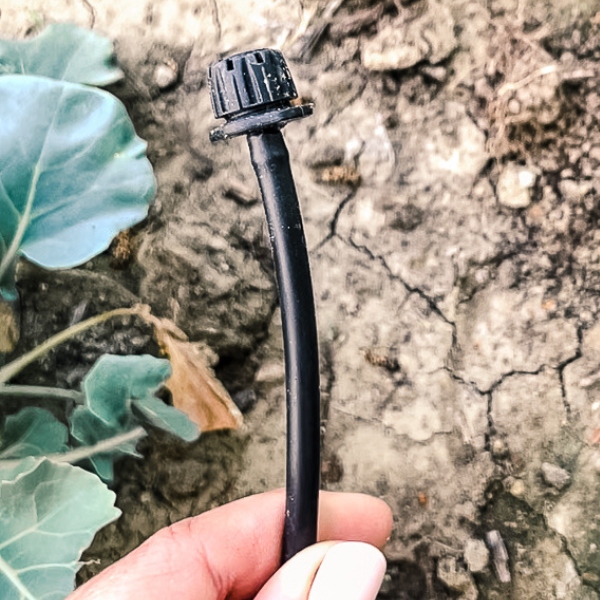

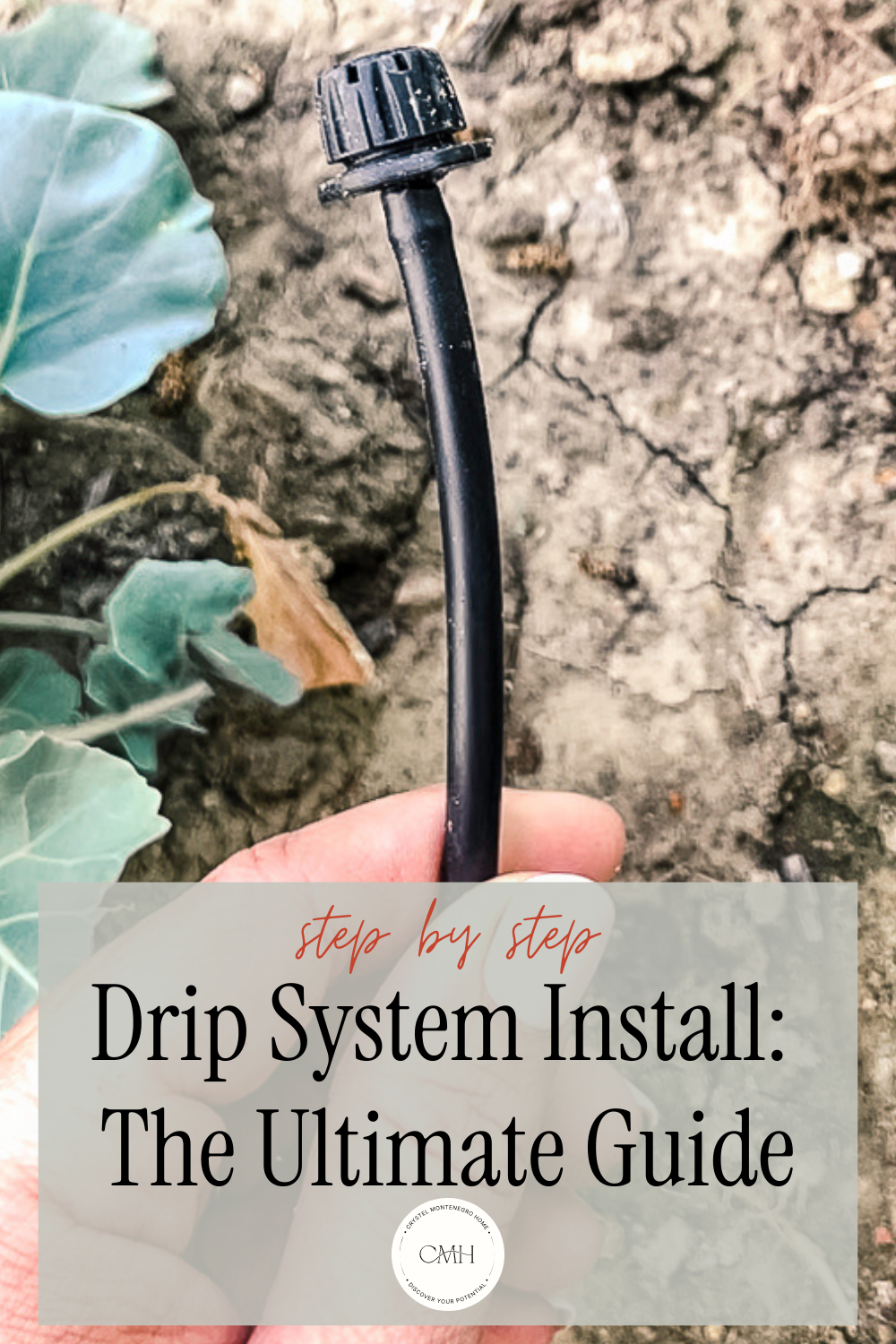
Thanks for the detailed instructions! When you winterize a system like this, do you just unscrew the splitter and the hose from the bib? And cap off the hose?
Yep! You got it!
Thanks for taking the time to help us learn things!